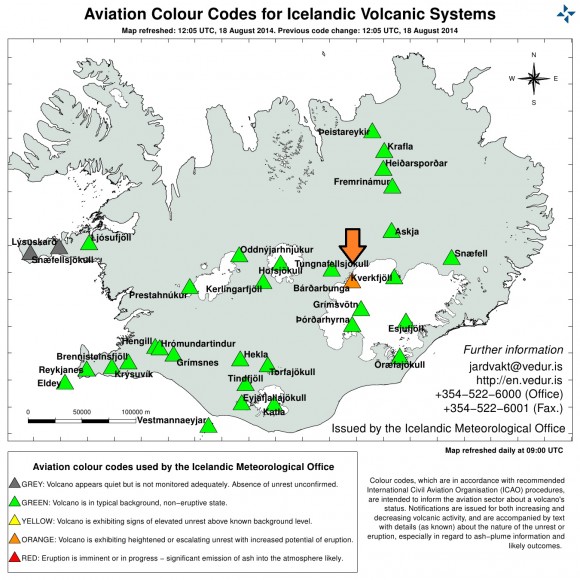
Will lava soon hit glacier ice, unleashing an explosion
that would spew ash and steam high in the atmosphere? The Icelandic Meteorology
Office (IMO) thinks that the probability of such an event in their country has
increased. Through August 16, 2014, the risk level had been at code green – a
“background, non-eruptive state.” The IMO has upgraded the risk twice in the last two days, on August 17
to code yellow, and early in the day on August 18 to code orange, indicating
that a “volcano shows heightened or escalating unrest with increased potential
of eruption.”
The focus of this IMO monitoring is on Bárðarbunga, a
volcano more than 2,000 meters in elevation, located beneath Vatnajökull, the country’s
largest glacier. Since midnight
on the morning of August 18, the IMO has detected about 950 earthquakes at
Bárðarbunga.
Since early June, the IMO has observed that four GPS
stations in the area have shown upward movement in a direction away from the
volcano. This movement suggests that a mass of magma (molten rock beneath the
Earth’s surface) has been expanding upward, closer to the Earth’s surface, and
displacing the GPS stations.
The IMO has been
particularly concerned by what it calls a “seismic swarm.” This refers to a
cluster of earthquakes.
This recent swarm began early in the day on August 16 and
has continued to the present. More than 1400 earthquakes have been recorded
since August 16, some small, some medium-sized, concentrated near the faults
associated with the volcano. These swarms constitute a second line of evidence
that an eruption may occur, since such earthquakes can be created by pools of
magma as they move upward.
The earthquakes in the last 24 hours have been more
numerous, more powerful, and closer to the surface—all pointing to an increased
likelihood of eruption.
The responsibility for monitoring such risks falls to the
IMO because sub-glacial
volcanic eruptions can create vast plumes of material that reach into the atmosphere.
This phenomenon is critical for Iceland because of its location on the paths of
many flights between western Europe and the East Coast of the US. When the
Eyjafjallajökull volcano erupted in this manner in April 2010, flights were
cancelled for six days, affecting ten million passengers. The lava was released
under a thick cap of glacier, creating a vast plume of ash and steam that was
propelled up to an elevation of 9,000 meters. The resulting cloud, presenting a
great threat to airplanes, was carried long distances by the jet stream. It
covered Norway, Sweden, Denmark, Britain and the Netherlands, as well as large
portions of Finland and Germany, and reached far into Russia. On a more
local scale, residents and domestic animals had to remain inside for a number
of days, and the rivers in the region were flooded with hot water. The ash-fall
covered fields and pastures, creating problems for farmers.


No comments:
Post a Comment